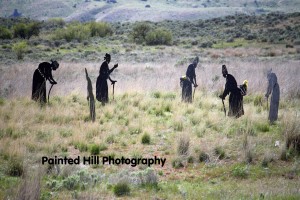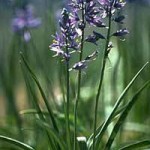Speckled Fish People: Roots and Berries: Five Fascinating Facts

Roots and berries were a life force for the Sinixt or Arrow Lakes People of Northeast Washington State. The People were semi-nomadic and would travel to the area within their territory where the roots are berries grew abundantly.
The spring months would burst forth fresh nourishment and bring one’s palate back to life. A long winter of dried foods was certainly valued yet would become mundane by the end of the cold, white season. The Lakes people would pack up come April and leave their winter camps in search of the new, crisp life.
They would travel to the plateau of northeast Washington and dig for camas, bitter root, wild onion, wild carrots, and much more. The women would do most of the root collecting while the men hunted for wild game. They used a tall, thin pica or root digger traditionally made of a hard wood such as willow, Black Hawthorn, Orangewood, or Saskatoon Berry with the top of which was sometimes made of the antler of an elk or deer. The stick was about three feet long and slightly curved. The handle was a short crosspiece of bone or antler.
These roots were boiled and dried to be pounded into cakes. The people demonstrated their thankfulness with the root feast each spring. The first roots gathered were ceremonially distributed and eaten by all in reverence to the Creator as I talked about in an earlier blog post. This ceremony was called the First Root Ceremony.
Camas and biscuit roots (also known as Kouse or Cous) were dug in June and July. Kouse had a parsnip-like flavor when fresh. These roots were dried, then ground into a meal. Mixed with water, the meal was then formed into cakes, and partly baked for storage. These cakes tasted like stale biscuits, giving the plant the common name of biscuitroot.
In the late summer, the People headed high into the mountains to collect huckleberries, chokecherries, raspberries, and blackberries. The berries were dried for winter use. The Arrow Lakes people ate the roots and berries as they picked them, but most were prepared for winter storage.
Five fun facts about roots and berries:
1 Cattails around the lake provided fresh green shoots in the spring and roots were harvested and roasted much like potatoes. Remember in the last post, the tule shoots were used to make baskets and mats.
2. Here is the Swarak’xn Choptikwl- The Frog Mountain Story as told by a Sinixt elder.
Frog Mountain Story
3. Camas is the bulb that comes from the wild lily.
4. Huckleberry leaves were dried and used for tea.
5. The pica or root digger was narrow and did not damage surrounding plants as it merely dug around the root the woman had her eyes on.
Haiku poem: Roots and Berries
Searching for the bulb
Wandering through the forest
Freshness in my mouth
Lakes Language as taught to me by Elder Marguerite Ensminger as seen in The Heart Trilogy by Carmen Peone.
Peena or Yumwha Basket
Pea- nuu or Yum- wah
Eat wa Black Camis
Eat- wah
Stalk Huckleberry
St- al (like talc but the a is pronounced ow)-k
What are your comments about roots and berries?

